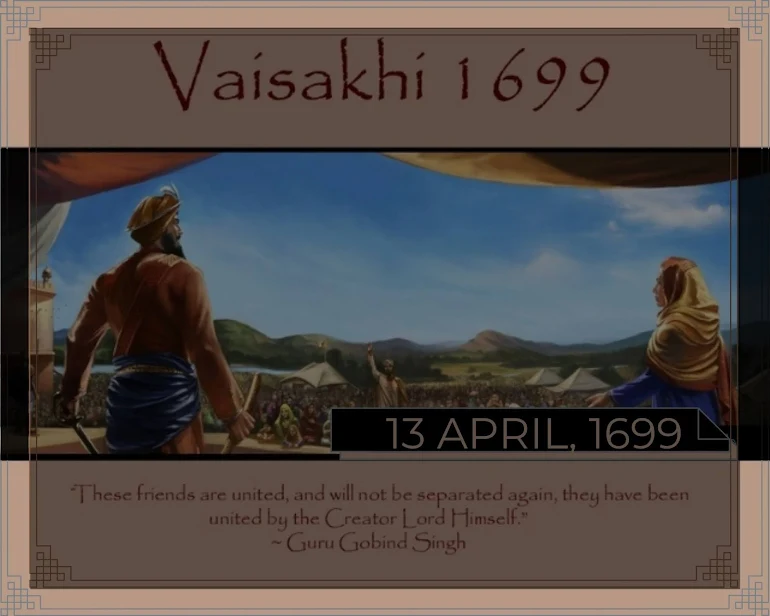BAISAKHI & THE KHALSA SAJNA DIWAS HISTORY 'OR' BIRTHDAY OF KHALSA (13 APRIL 1699): WHY IS VAISAKHI CELEBRATED
Baisakhi is mainly a day of thanksgiving in which farmers thank the Lord for the harvest and pray for future prosperity. Vaisakhi also known as Khalsa Sajna Diwas 'or' the birth of Khalsa Day falls on April 13, every year.
9 POINTS ON WHY THIS AUSPICIOUS DAY OF THE VAISAKHI IS CELEBRATED
1. Baisakhi is derived from the word 'Baisakh', the second month of the Sikh calendar (Nanakshahi calendar). It heralds the start of a new year of harvest for the village.
2. Baisakhi is mainly a day of thanksgiving in which farmers thank their Lord for the harvest and pray for future prosperity.
3. On Vaisakhi, Punjabis observe a practice known as Aawat Pauni. People come together to harvest wheat that grew over the winter. While harvesting, drums are played and people recite Punjabi Doha (couplet) to the tune.
4. Baisakhi also commemorates Khalsa's birth. Guru Gobind Singh gathered his followers at his homeland in Anandpur on March 30, 1699. Khalsa was born on this special occasion.
5. During a meeting at his residence, Guru Gobind Singh requested any volunteer to sacrifice his head for the sake of Religion. Daya Ram offered his head and the Guru led him inside a tent, emerging later with a bloody sword. He called for another volunteer and repeated the four times more.
6. Guru emerged from the tent with the five volunteers, and five headless bodies were discovered inside. After that, those dead bodies were brought in front of the Congregation & the heads of those five volunteers were again placed on different bodies in front of the Sangat ( Congregation ). The Guru gave these five Sikh volunteers, the name Panj Pyaare, which means "the five beloved ones ( of the LORD )." Daya Ram, also known as Bhai Daya Singh, Dharam Das, also known as Bhai Dharam Singh, Himmat Rai, also known as Bhai Himmat Singh, Mohkam Chand, also known as Bhai Mohkam Singh, and Sahib Chand, also known as Bhai Sahib Singh were the five volunteers. These were the first among the Sikh community (that is not a religion but a community only, which is above all religions as told by Lord Gobind & the only religion to follow is Lord & Lord's Name, so as the verses of Gurubani Guroo Jee Maharaj:
In Gurmukhi Script (Punjabi Script):
ਸਰਬ ਧਰਮ ਮਹਿ, ਸ੍ਰੇਸ਼ਠ ਧਰਮ ||
ਹਰਿ ਕੋ ਨਾਮ ਜਪਿ ਨਿਰਮਲ ਕਰਮ ||
Gurmukhi Script was initially started by Guru Nanak Dev Ji (first Guru of the SIkhs) as per Lord's order & then Guru Angad Dev Ji completed the gurmukhi text-script & recorded the first Guru's Bani (i.e. Japji Sahib) safely in written form & the same textual script has been used to write Gurbani by the following Sikh Gurus (upto 10th Guru).
In Latin Script (English Language):
SARAB DHARAM MEH, SARESAT DHARAM ||
HAR KO NAAM, JAP NIRMAL KARAM ||
In Devnagri Script (Hindi Language):
सरब धरम मेह, स-रेष्ठ धरम ||
हर को नाम, जप निर्मल करम ||
7. Guru Gobind Singh also established the Khalsa Vani at the 1699 gathering - " Waheguru Ji ka Khalsa, Waheguru Ji ki Fateh ||". He gave all of his followers the title 'Singh,' which means "Lion". He also developed the Khalsa principles, also known as the Five 'K's: Kes, Kangha, Kada, Kirpaan & Kacchera as the Symbols of the LORD to put the subtle & physical restrictions on the mind & to protect the beings from doing sins:
a. KADA [K'DAA / IRON RING]: to put the restriction on our hands, that we should not do sins with these hands.
b. KANGHA [WOODEN COMB]: To relieve the stress generated due "-ve" charge of electrons & also protect us from several diseases.
c. KES: These are the symbols of the Lord that whatever, nature created by Lord has provided us is Good & also there is a stage in divineness. (Not to consider Nails as these are dead cells that can harm us & anybody.)
d. KIRPAN [SWORD]: To maintain integrity in the phase of true religion, According to the Lord's Order, Guru Sahib also provides the Sikh, a sword for defensive purposes & to take strict actions against cruel leadership going against the verdicts of humanity.
e. KACCHERA [LOOSE LOWER (UNDER) WEAR MADE OF WHITE CLOTH]: The Kacchera is the Guru's gift & it reminds the Sikhs of the Guru's message regarding the control of the Five Evils, especially lust.
9. At this time of year, other parts of India celebrate New Year festivals such as Baisakhi. Bengalis celebrate Poila Boishakh (Bengali New Year), Assamese celebrate Bohag Bihu (Assamese New Year), and Tamil Nadu celebrates Puthandu (Tamil New Year).
SUMMARY: On the eve of Baisakhi on 13 April 1699, Lord Gobind (on the land of Shri Anandpur Sahib) liberated the holy congregation in millions of numbers by offering them the sweet nectar of the lord's feet prepared with the help of the lord's name or lord's voice (Gurbani is the form of Lord's Voice).
That's All,Keep Reading,
A Reader is a Leader.
MADE & WRITTEN WITH ❤️ BY:
WFEED & WITFEED
TOPIC: BAISAKHI & THE KHALSA SAJNA DIWAS 'OR' BIRTHDAY OF KHALSA: WHY IS VAISAKHI CELEBRATED?















0 Comments